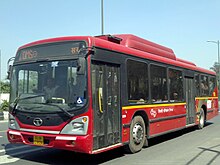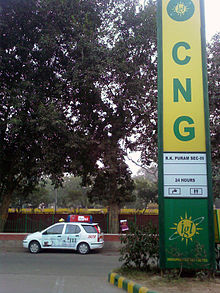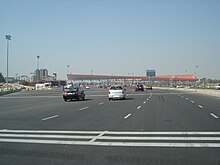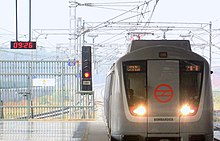|
Transport in Delhi
 Delhi has significant reliance on its transport infrastructure. The city has developed a highly efficient public transport system with the introduction of the Delhi Metro,[1] which is undergoing a rapid modernization and expansion since 2006.[2] There are 16.6 million registered vehicles in the city as of 30 June 2014, which is the highest in the world among all cities, most of which do not follow any pollution emission norm (within municipal limits), while the Delhi metropolitan region (NCR Delhi) has 11.2 million vehicles. Delhi and NCR lose nearly 42 crore (420 million) man-hours every month while commuting between home and office through public transport, due to the traffic congestion.[3] Therefore, serious efforts, including a number of transport infrastructure projects, are under way to encourage usage of public transport in the city.[4] HistoryPrior to independence in the 1940s, public transport in the city was in private hands, with people relying mainly on tongas [citation needed] and the bus service of the 'Gwalior Transport Company' and 'Northern India Transport Company'.[5] But with the growing city, it soon proved inadequate, thus Delhi Transport Corporation (DTC) bus system was established in May 1948. The next big leap in city transport was the opening of Delhi Metro, a rapid transit system in 2002. OverviewPublic transport in the metropolis includes the Delhi Metro, the Delhi Transport Corporation (DTC) and DIMTS (Delhi Integrated Multi Modal Transit System) bus system, auto-rickshaws, cycle-rickshaws, e-rickshaws, Grameen Seva and taxis. With the introduction of Delhi Metro, a rail-based mass rapid transit system, rail-based transit systems have gained ground. Other means of transit include suburban railways, inter-state bus services and private taxis which can be rented for various purposes. However, buses continue to be the most popular means of transportation for intra-city travel, catering to about 60% of the total commuting requirements.[6] Private vehicles account for 30%[citation needed] of the total demand for transport, while the rest of the demand is met largely by auto-rickshaws, taxis, rapid transit system and railways. Indira Gandhi International Airport (IGI) serves Delhi for both domestic and international air connections, and is situated in the south-western corner of the city. In 2009–2010, IGI recorded a traffic of more than 25.01[7] million passengers, both Domestic and International.[8] Heavy air traffic has emphasised the need for a secondary airport, which is expected to be Taj International Airport near Greater Noida, alongside the Delhi-Agra highway. The only international rail service in Delhi was the Samjhauta Express to Lahore,which was stopped in 2019 following a standoff. It is possible to change trains to board rail services to Bangladesh and Nepal which commence in other cities of India. For the future, a high-speed rail link is being considered that would link New Delhi with Kunming, China via Myanmar[9] Intra-city TransportRoad transportRoads in Delhi are maintained by the Municipal Corporation of Delhi, New Delhi Municipal Council, Delhi Cantonment Board, Public Works Department and Delhi Development Authority. At 1749 km of road length per 100 km2, Delhi has one of the highest road densities in India. Major roadways include the Ring Road and the Outer Ring Road, which had a traffic density of 110,000 vehicles per day in 2001. Total road length of Delhi was 28,508 km including 388 km of National Highways. Major road-based public transport facilities in Delhi are provided by DTC buses, auto-rickshaws, taxis and cycle-rickshaws. BusesDelhi Transport Corporation (DTC) operates the world's largest fleet of CNG-powered buses. After Pune, Delhi was the second city in India to have an operational Bus rapid transit (BRT) system. However the BRT was dismantled in 2016 due to accidents and congestion.[10]  Delhi has one of India's largest bus transport systems. Buses are the most popular means of transport catering to about 60% of Delhi's total demand.[11] Buses are operated by the state-owned Delhi Transport Corporation (DTC), which owns largest fleet of Compressed Natural Gas (CNG)-fueled buses in the world, private Blueline bus operators and several chartered bus operators. It is mandatory for all private bus operators to acquire a permit from the State Transport Authority. The buses traverse various well-defined intra-city routes. Other than regular routes, buses also travel on Railway Special routes; Metro Feeder routes. Mudrika (Ring) and Bahri Mudrika (Outer Ring) routes along Ring and Outer-Ring road respectively are amongst the longest intra-city bus routes in the world. The DTC has started introducing air-conditioned buses and brand new low-floor buses (with floor height of 400 mm and even higher on one third area as against 230 mm available internationally.) on city streets to replace the conventional buses. A revamp plan is underway to improve bus-shelters in the city and to integrate GPS systems in DTC buses and bus stops so as to provide reliable information about bus arrivals. In 2007, after public uproar concerning the large number of accidents caused by privately owned Blueline buses, the Delhi government, under pressure from the Delhi High Court decided that all Blueline Buses shall be phased out and be eventually replaced by low floor buses of the state-owned DTC.[12] The Delhi Government has decided to expedite this process and will procure 6,600 low floor buses for the DTC by commonwealth games next year in mid 2020.[13] As of May 2023, the fleet size of buses in Delhi is as follows:
Auto-rickshawsThe auto-rickshaws (popularly known as Auto) are an important and popular means of public transportation in Delhi, as they are cheaper than taxis. Hiring an Auto in Delhi is very tricky, as very few auto-drivers agree to standard meter charges. The typical method is to haggle for an agreeable rate. Taxis  Though easily available, taxis are not an integral part of Delhi public transport. There are over 113 registered taxis. The Indian Tourism Ministry and various private owners operate most taxis. The Tourism Ministry grants private companies permits to operate taxis. Recently, Radio Taxis have started to gain ground in Delhi. Some companies provide an on-call radio taxi service, which is slightly more expensive than conventional Black and Yellow taxis. Cycle-rickshawsCycle-rickshaws are a popular mode of travel for short distance transits in the city. The pedal-powered rickshaws are easily available throughout the city and reckoned for being cheap and environment friendly. Often, tourists and citizens use them for joyrides, too. Of late, they have been phased out from the congested areas of Chandni Chowk because of their slow pace, which often leads to traffic snarls on the streets of Old Delhi. Still, they are the great source of public transport in Delhi. Major Arteries Inner Ring RoadInner Ring Road is one of the most important "state highways" in Delhi. It is a 51 km long circular road, which connects Northern, eastern, Western and Southern areas in Delhi. Owing to more than 2 dozen grade-separators/flyovers, the road is almost signal-free. The road is generally 8-laned with a few bottlenecks at certain stretches, which are being removed. The road has already achieved its carrying capacity of 110000 vehicles per day and would require an addition of more lanes to fulfill needs of increasing traffic by 2011. Outer Ring RoadOuter Ring Road is another major artery in Delhi. The road which was almost neglected till the early 2000s is now an important highway that links far-flung areas of Delhi. The road is 6-8 lane and has grade-separators and a large number are under construction as a part of project to make the artery signal free. The road along with the ring road forms a ring which intersects all the National Highways passing through Delhi. Expressways and National Highways Delhi is connected by NH 1, NH 2, NH 8, NH 10 and NH 24. It also has three expressways (six- and eight-lane) that connect it with its suburbs. Delhi–Gurgaon Expressway connects Delhi with one of its financial hubs, Gurgaon, DND Flyway connects Delhi with its other financial hub, Noida and Delhi–Faridabad Skyway which connects Faridabad, major suburb to Delhi. Four more expressways are also planned.  Noida–Greater Noida Expressway connects Noida with Greater Noida, which is an upcoming financial and commercial hub and is also to have a new Jewar International Airport. A 135.6-km long Western Peripheral Expressway, also known as the Kundli–Manesar–Palwal Expressway, which became operational on 19 November 2018, will relieve Delhi of the congestion of heavy night traffic and will act as a bypass for the night vehicles. NH 24 or Ghaziabad Road is a four-lane national highway which connects Delhi to Lucknow via Ghaziabad. As the Commonwealth Village is located close by Yamuna bridge on this highway, underpasses and flyover being built will help facilitate traffic between the eastern areas of Delhi/ Western UP and the rest of the city. Rail transportRail based transport in the city has started to gain popularity with the introduction of Delhi Metro. Ring-Railway, which runs parallel to the Ring-Road system is another rail-based intra-city transport facility in Delhi. Metro Railway The Delhi Metro is being built in phases. Rapid increase of population coupled with large-scale immigration due to high economic growth has resulted in ever increasing demand for better transport, putting excessive pressure on the city's existent transport infrastructure. Like many other cities in the developing world, the city faces acute transport management problems leading to air pollution, congestion and resultant loss of productivity. In order to meet the transportation demand in Delhi, the State and Union government started the construction of a Mass Rapid Transit system, known as Delhi Metro in 1998. The project started commercial operations on 25 December 2002 between Shahdara and Tis Hazari) on the Red Line. It has set performance and efficiency standards and is continuously expanding. As of January 2022, the network consists of nine colour-coded regular lines along with the faster Airport Express line, with a total length of 348.12 kilometres (216.31 mi)[19] serving 254 stations.[19] The system has a mix of underground, at-grade, and elevated stations using both broad-gauge and standard-gauge.[20] Phases III (112 km) and IV (108.5 km) will be completed by 2018 and 2025 respectively, with the network totaling 413.8 km, making it longer than the London Underground. Phase I consisted of 58 stations and 65.0 km (40.4 mi) of route length,[21] of which 13.0 km (8.1 mi) is underground and 52.1 km (32.4 mi) surface or elevated. The inauguration of the Dwarka–Barakhamba Road corridor of the Blue Line marked the completion of Phase I in October 2006.[22] Phase II of the network consists of 124.6 km (77.4 mi) of route length and 85 stations,[21] and is fully completed, with the first section opened in June 2008 and the last line opened in August 2011.[23] Phase-III has 28 underground stations, 2 new lines and 11 route extensions, totaling 167.27 km (103.94 mi), with a cost of ₹350 billion (US$4.0 billion) and having an expected completion date of mid 2019. Phase IV (113.2 km or 70.3 mi) is planned to be completed by 2025.[24] Delhi Metro lines that operate as of January 2022:
 Ring & Suburban Railway Ring railway is a 35-kilometre circular railway network in Delhi that runs parallel to the Ring Road. It was laid back in 1975 primarily to service freight trains that could bypass the crowded and passenger-heavy Old Delhi and New Delhi railway stations. The network was upgraded for the 1982 Asian Games with the introduction of 24 additional services. Its circular route is 35 km (22 mi) long, which the trains takes 90–120 minutes to complete, both clockwise and anti-clockwise, via the Hazrat Nizamuddin Railway Station. The ring railway service was quite popular through the 80s and 90s when Delhi's transport infrastructure was just gathering pace, but since then, with the rapid expansion of the Delhi Metro coupled with an extensive bus network, the ring railway has remained neglected by the city as well as the Railways. On average, only 3700 passengers take the trains every day. The biggest reason for the failure of the railway is a lack of a feeder network, such as approach roads and feeder buses to the stations. The stations are situated at remote locations and are difficult to access by passengers. There is also a problem of security as many stations have been encroached. The trains on this network also run behind schedule most of the time. The network is now utilized as a freight corridor and limited passenger train services are available during peak hours.[27][28][29] Inter-state transportRailway connectivityDelhi is connected to whole of the nation through Indian Railways vast network. New Delhi Railway Station which is one of the most busiest stations in Indian Railway system serves as headquarters of Northern Railways. A large load of inter-state transport is borne by railways. A large number of local passenger trains connect Delhi to its sub-urban areas and thus provide convenient travel for daily commuters. Railways also share a large amount of freight traffic in Delhi. Train ServicesRegular train services available from railway stations in the city. The services are extended to all the states in the country. Services are provided by the national railway operator Indian Railways. The 5 railway stations in the city are:
Regional Rapid Transport System (RRTS/RapidX)
Delhi MetroRoadHighwaysThe city is believed to have the highest road density in the country and is well connected to the rest of the nation through five major national highways, namely NH 1, NH 2, NH 8, NH 10 and NH 24. The highways around city are being upgraded into expressways with ultra-modern facilities. Bus services
Regular bus services are available from interstate bus terminals in the city. The services are extended to all the northern states and the neighbouring areas of Delhi. Services are provided by state transport corporations and several private operators. Delhi Transport Infrastructure Development Corporation Limited (DTIDC) operates 4 major Inter-State Bus Terminals (ISBT):[30]
AirportsIndira Gandhi International Airport (IGI) serves Delhi for both domestic and international connections, and is situated in the southwestern corner of the city, alongside Delhi-Gurgaon Expressway. In the year 2015–16, IGI recorded a traffic of over 48 million passengers.[33] Being the busiest airport in the South Asian region, IGI airport has three terminals - Terminal 1 & Terminal 2 for domestic operations only and Terminal 3 - with mixed use i.e. primary International and the rest of the domestic operations(Vistara and Air India) - in addition of T1 & T2[34] The airport was and still witnessing massive expansion and modernisation by a consortium led by GMR Infra. The new Terminal T3 was inaugurated in 2010 in line of the historic Commonwealth Games being held and Delhi is today India's only city to have an airport of this size. Terminals 4, 5 and 6 will be built in a phased manner. By 2024, airport will have four runways and will handle more than 100 million passengers per year.[35] Hindon Domestic Airport in Ghaziabad was inaugurated by Prime Minister Narendra Modi as the second airport for the Delhi-NCR Region on the 8 March 2019.[36] Apart from the expanded IGI airport, Delhi might also receive a second international airport by 2024. The airport, being named as Taj International Aviation Hub, is proposed to be located in Jewar in Greater Noida. It would be around 75 km from IGI airport. East-west connectivity bridgesYamuna bridges in Delhi The total length of the Yamuna inside Delhi is 22 km from the Wazirabad barrage to the Okhla barrage. This stretch of the river has 14 bridges (nine of them for road traffic), including those built by Delhi Metro (4) and Indian Railways (1). 4 bridges are under construction — 1 for road traffic and 3 for rail traffic.[37][38][39]
Other bridges in NCRFuture projects
There are many transport infrastructure projects underway in Delhi. Most had their deadlines set in late 2009 and early 2010, just before the 2010 Commonwealth Games. As of 2023, most of them have been completed. They are listed below - Rail
Road
Air
Delhi Traffic Police transport helplineOwing to a large number of complaints from consumers, the Delhi Government in association with Delhi Traffic Police runs a staffed transport helpline which can be reached at 011-23010101 while dialing from within the city. Citizens can make traffic related complaints and suggestions. One can also report traffic violations observed and misbehavior/refusal/overcharging by autorickshaws, buses and taxis.[50] See also
References and notes
External linksWikivoyage has a travel guide for Delhi. |
|||||||||||||||||||||||||||||||||||||||||||||||||||||||||||||||||||||||||||||||||||||||||||||||||||||||||||||||||||||||||||||||||||||||||||||